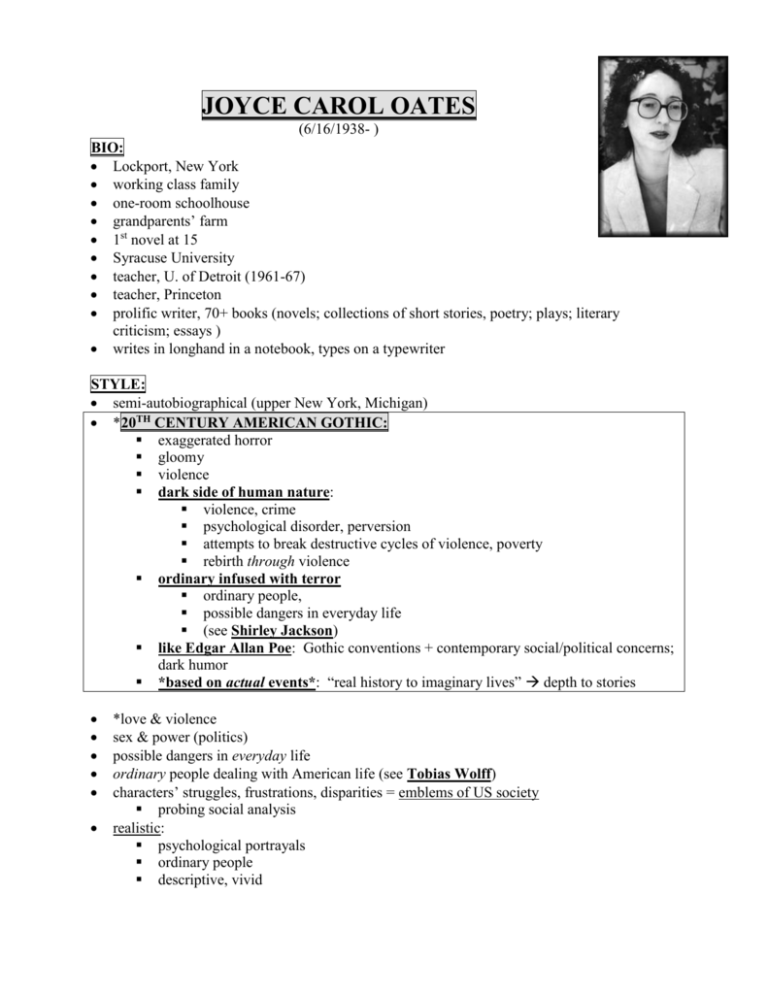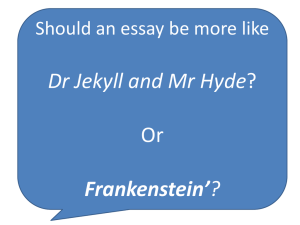JOYCE CAROL OATES
advertisement

JOYCE CAROL OATES (6/16/1938- ) BIO: Lockport, New York working class family one-room schoolhouse grandparents’ farm 1st novel at 15 Syracuse University teacher, U. of Detroit (1961-67) teacher, Princeton prolific writer, 70+ books (novels; collections of short stories, poetry; plays; literary criticism; essays ) writes in longhand in a notebook, types on a typewriter STYLE: semi-autobiographical (upper New York, Michigan) *20TH CENTURY AMERICAN GOTHIC: exaggerated horror gloomy violence dark side of human nature: violence, crime psychological disorder, perversion attempts to break destructive cycles of violence, poverty rebirth through violence ordinary infused with terror ordinary people, possible dangers in everyday life (see Shirley Jackson) like Edgar Allan Poe: Gothic conventions + contemporary social/political concerns; dark humor *based on actual events*: “real history to imaginary lives” depth to stories *love & violence sex & power (politics) possible dangers in everyday life ordinary people dealing with American life (see Tobias Wolff) characters’ struggles, frustrations, disparities = emblems of US society probing social analysis realistic: psychological portrayals ordinary people descriptive, vivid 2 minute detail extended dialogue minute detail violent action perversion, mental derangement (her fascination with psychological & social disorder) SETTINGS: Eden County (fictionalized Erie County) (see her biography) Detroit (see her biography) suburbia CHARACTERIZATION: psychological backgrounding search/struggle for personal identity ordinary people, in contemporary American society various social classes, American subgroups THEMES: “I am a chronicler of the American experience.” “the moral and social conditions of my generation” examines the relationship between love & violence in American society self-discovery violence and victimization GENRES: poetry short story drama fiction: novels Gothic novels (neo-Gothic: ghosts, mansions, mysteriousness – based on actual events) (see Shirley Jackson) themes: crimes against women, children, poor; family shapes destiny horror courtroom drama mystery novels suspense novels non-fiction: sports philosophy critical essays literature politics sports life 3 "WHERE ARE YOU GOING, WHERE HAVE YOU BEEN?" (1966) First published in Epoch, Fall 1966. Included in Prize Stories : O Henry Award Winners (1968), and The Best American Short Stories (1967). sexual awakening of 15-year-old, Connie mysterious older man, Arnold Friend “brave, new world” of adult life, fraught with danger, peril, fear MIRANDA: O wonder! How many goodly creatures there are here! How beauteous mankind is! O brave new world That has such people in't! PROSPERO 'Tis new to thee. Act V, Scene I. The Tempest (Shakespeare) dangers of everyday life ordinary, typical teenager 5 critical interpretations 1) feminist allegory 2) Story as a dream, Arnold as symbolic of Connie's fear of the adult world 3) Arnold as symbolic Satan 4) Arnold as symbolic Savior 5) Arnold as creep (not really a symbol) Laura Dern, Treat Williams in Smooth Talk (1986) 4









